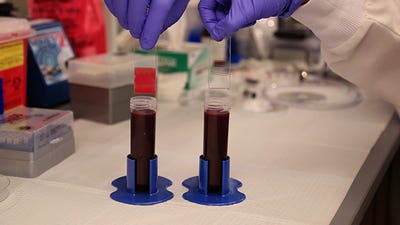October 14, 2014
When it comes to medtech devices, we've certainly come a long way over the last decade or so, but two constant challenges remain: blood clotting and bacterial infections. That is, until a team of Harvard scientists began working toward a solution involving a substance similar to Teflon.
|
Photo depicting two glass slides dipped in blood. While blood sticks to the untreated slide on the left, the slide on the right coated in the repellent materials developed by Harvard scientists emerges almost entirely clear. (Photo courtesy of Harvard University.) |
Harvard recently released details about a new surface coating for medical devices that can repel blood and bacteria, helping the body stave off infection and avoid harmful blood clotting. The team began by chemically attaching a monolayer of perfluorocarbon, a Teflon-like substance, before adding an additional layer of liquid perfluorocarbon. (A polymerized fluorocarbon, tetrafluoroethylene, is actually used to manufacture polytetrafluoroethylene (PTFE), marketed under the trade name Teflon by Dupont.)
Researchers refer to the substance as Tethered-Liquid Perfluorocarbon, or TLP. The recent study was reported in Nature Biotechnology, where researchers detailed how the TLP coating was developed from materials that have already been approved by the FDA.
The genesis of the materials for the coating solution evolved from a pioneering surface technology known as SLIPS, which stands for Slippery Liquid-Infused Porous Surfaces. The idea was partly inspired by the carnivorous pitcher plant, the slippery surfaces of which allow the plant to capture insects. SLIPS is specifically designed to repel nearly any material it contacts, providing a platform that can create slippery, non-adhesive surfaces on any device.
The demand for implantable medical devices is expected to soar over the $50B mark by next year, as technological advances in the field continue to push the envelope.
"Devising a way to prevent blood clotting without using anticoagulants is one of the holy grails in medicine," Donald Ingber, the Judah Folkman Professor of Vascular Biology at Harvard Medical School and senior author of the study, said in a Harvard news release.
Ingber is also the founding director of Harvard's Wyss Institute for Biologically Inspired Engineering, an institute devoted to developing innovative new engineering solutions for healthcare, using bioinspired materials that can transform medicine and foster a more sustainable world.
It was in this spirit that researchers sought to develop a super-repellent coating that can be adhered to implantable medical devices, in an effort to address the aforementioned issues of clotting and bacterial infection. The team implanted medical-grade tubing and catheters coated with the repellent material inside large blood vessels in pigs, and found that it prevented blood from clotting for at least eight hours without the use of blood thinners.
Researchers also found that medical tubing coated in the new repellent materials could be stored for more than a year under normal temperatures and humidity conditions and still prevent clot formations. The team even attempted to grow bacteria inside the tubing coated with the repellent materials, and found that less than one in a billion bacteria were able to adhere to the substance.
Out of mere curiosity, the team even tested the surface of the materials with a gecko, nature's sultan of sticky, whose footpads contain thousands of hair-like structures with unbelievable adhesive strength. Even the gecko was unable to hold on to the surface coated with the materials.
While the bulk of the team's trials were performed on medical devices such as catheters and perfusion tubing, they believe they're just scratching the surface of the capabilities of this substance. "[The technology] could become a new paradigm for implantable medical devices, extracorporeal circuits, and more," said Ingber.
While trials continue, the progress has been very promising for the new innovative coating material, paving the way for implantable medical technology to transform medicine in exciting new ways.
Chris Newmarker contributed to this story.
Refresh your medical device industry knowledge at MD&M Chicago, October 15-16, 2014, and MD&M Minneapolis, October 29-30, 2014. |
Kristopher Sturgis is a contributor to Qmed and MPMN.
Chris Newmarker is senior editor of Qmed and MPMN. Follow him on Twitter at @newmarker.
Like what you're reading? Subscribe to our daily e-newsletter.
About the Author(s)
You May Also Like



